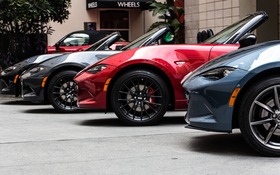Mazda MX-5: A Great Product With An Uncertain Future?
When I recently travelled to California to test the 2016 Mazda MX-5, I seized the opportunity to chat with Mark Peyman, National Manager, Product Strategies & Development at Mazda Canada. I asked him point-blank when a hard top will be available; after all, even though hard tops are less sporty, they’re safer and better insulated, and lots of potential buyers are waiting for a hard top version.
Neither confirmed nor denied
All that Peyman said was that a hard top version is being discussed, but isn’t officially in the works yet. And when I asked if a Speed version, or at least a performance version, was on its way, I got the same answer: We’ll see. Mazda isn’t confirming or denying anything.
- Also: US Invasion By The Mazda MX-5
- Also: The First Crashed Mazda MX-5 Is Replaced By The Manufacturer
For a lot of people, this seems normal. The company is waiting to see if the new model sells in good numbers before moving ahead with other versions. In the marketing world, the belief is that new products should be as simple as possible in order for them to catch on—the offer can always be enhanced later.
But a quick look at the MX-5’s sales numbers reveals a problem: sales are in a dramatic decline!
Hurry up and buy another Miata!
To be fair, it’s perfectly normal that buyers hold back before a new model is released. They’re waiting for big deals or news of a new generation. Last year, 13,770 units of the MX-5 were sold. That’s a record low since the model was first introduced in 1989, and a far cry from its peak of 75,798 units sold in 1990.
In 2005, Mazda sold 25,263 Miatas. In 2006, this number almost doubled to 44,243—probably thanks to the release of a new gen. Since then, there’s been a steady decline:
- 2007: 41,574 units
- 2008: 28,743 units
- 2009: 22,139 units
- 2010: 20,066 units
- 2011: 16,582 units
- 2012: 15,836 units
- 2013: 13,778 units
For 2014, I only have the figures from January to June. At 6,906, these numbers imply that sales were about the same as in 2013.
But as long as sales stay under the 40,000 bar, I’d be very surprised to see Mazda invest in variants of a model like the Miata.
When do you recall a vehicle for being too reliable?
The problem with the MX-5 is that it is too reliable. Owners of older vehicles are finding themselves with cars that just won’t break. Since they still work, why buy a new one?
Some people are also asking whether it still makes sense to sell a 155-horsepower sports car for more than $30,000.
Whatever the answer, Mazda has to find a way to boost sales of the MX-5. Personally, I tested the current version and thought it was terrific. It certainly deserves a sportier version—but we’ll need to see much stronger sales for that to happen.












